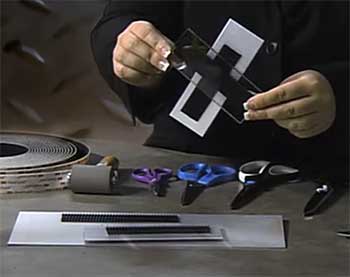Fasteners have revolutionized the way we connect and secure objects. When it comes to reliability and versatility, 3M Dual Lock™ and Velcro fasteners have always been the forerunners.
Let’s dive into the details of these heavy-duty fasteners to understand their potential, pros, cons, and compatibility.
A Comprehensive Comparison Table
| Features | 3M Dual Lock™ | Velcro Fasteners |
| Design | Mushroom-shaped stems that interlock | Hook and loop system |
| Durability | High (Up to 1000 closures) | Moderate |
| Resistance to Weather | High resistance to heat, humidity, UV radiation | Lower resistance compared to Dual Lock™ |
| Compatibility | Poor compatibility with other hook-and-loop fasteners | Good compatibility with other hook-and-loop fasteners |
| Strength | High tensile strength | Lower tensile strength |
| Cost | More expensive | More affordable |
| Versatility | Excellent for heavy-duty applications | Excellent for everyday use |
| Ease of Use | Requires more effort to open and close | Very easy to use, even for children |
The Stalwart: 3M Dual Lock™
3M Dual Lock™ fasteners have made their mark in various industries due to their exceptional strength and durability. With a unique design that includes hundreds of mushroom-shaped stems that interlock with one another, the Dual Lock™ offers superior tensile strength.
Pros of 3M Dual Lock™

- High Performance: One of the significant advantages of the 3M Dual Lock™ is its ability to offer five times more strength than a typical hook-and-loop fastener. It’s suitable for heavy-duty applications where durability and stability are paramount.
- Repeated Usability: The Dual Lock™ can be opened and closed up to 1000 times without any notable degradation in its fastening ability. This reusability makes it a cost-effective choice for long-term use.
- Weather Resistance: The Dual Lock™ is highly resilient to harsh weather conditions and can withstand heat, humidity, and UV radiation, making it perfect for outdoor use.
Cons of 3M Dual Lock™
- High Cost: The 3M Dual Lock™ is often priced higher than its competitors. The cost might be a hindrance for those on a tight budget.
- Compatibility Issues: Dual Lock™ doesn’t mesh well with standard hook-and-loop fasteners like Velcro, limiting its versatility.
The Classic: Velcro Fasteners
Velcro fasteners are a well-established name in the world of fasteners, offering ease of use and versatility. It’s a simple yet effective two-component system of loops and hooks that interlock for secure fastening.
Pros of Velcro Fasteners

- Versatility: Velcro fasteners are incredibly versatile, working well for a wide range of applications from crafting to industrial usage.
- Ease of Use: The design of Velcro fasteners makes them user-friendly, and even children can operate them without any difficulty.
- Affordability: One of the main advantages of Velcro is its affordability, making it accessible for a wide range of users.
Cons of Velcro Fasteners
- Limited Durability: While Velcro is suitable for everyday use, it may not withstand high-stress applications like Dual Lock™ does.
- Loss of Strength Over Time: Velcro fasteners can lose their grip strength over time, especially when exposed to dirt and lint, which can get entangled in the loop component.
Key Differences Between 3M Dual Lock™ And Velcro Fasteners
Understanding the nuances between 3M Dual Lock™ and Velcro fasteners can aid in selecting the ideal choice for your specific needs. In this segment, we’ll discuss their key differences in detail.
- Design Architecture
The most fundamental difference lies in the design of the two fasteners.
3M Dual Lock™
This fastener utilizes mushroom-shaped stems that interlock with each other, offering robust connections. This unique design is responsible for its high tensile strength, making it an excellent choice for heavy-duty applications.
The interlocking mechanism provides a secure closure, and it is this characteristic that grants the Dual Lock™ its increased holding power.
Velcro Fasteners
Velcro, on the other hand, uses a loop and hook system. The soft loop side meshes with the stiff hook side to create a secure connection. While not as strong as the Dual Lock™, this design has stood the test of time and proven to be incredibly versatile and user-friendly.
- Durability and Resilience
The difference in design leads to a disparity in durability and resilience.
3M Dual Lock™
With its mushroom-shaped stems, the Dual Lock™ offers superior strength and longevity. It can be opened and closed up to a thousand times without any notable degradation in its fastening ability.
Moreover, the Dual Lock™ exhibits remarkable resistance to harsh weather conditions, including heat, humidity, and UV radiation.
Velcro Fasteners
Velcro fasteners don’t fare as well under high-stress scenarios and aren’t as durable as the Dual Lock™. Over time, especially when exposed to dirt and lint, Velcro can lose its grip strength.
However, for everyday applications, Velcro fasteners are sufficiently durable and dependable.
- Compatibility
Another major difference is their compatibility with other fasteners.
3M Dual Lock™
Due to its unique design, the Dual Lock™ isn’t compatible with standard hook-and-loop fasteners like Velcro. This constraint somewhat limits its versatility.
Velcro Fasteners
In contrast, Velcro, with its traditional hook-and-loop system, enjoys better compatibility with other hook-and-loop fasteners in the market.
- Cost
When it comes to cost, the two fasteners have noticeable differences.
3M Dual Lock™
The advanced features and superior durability of the Dual Lock™ make it a premium product, and it is often priced higher than its competitors.
Velcro Fasteners
Velcro is much more affordable, making it a popular choice for casual users and budget-conscious customers.
Frequently Asked Questions (FAQ)
Indeed, 3M Dual Lock™ is generally stronger than Velcro. Its unique mushroom-shaped stem design offers higher tensile strength and durability, making it more suited for heavy-duty applications.
While both are fasteners, their design, functionality, and strength differ significantly. Dual Lock™ has interlocking mushroom-shaped stems, offering superior strength and resistance to weather conditions. On the other hand, Velcro uses a simple loop and hook design, making it user-friendly, versatile, but less resilient in high-stress scenarios.
No, 3M Dual Lock™ is not considered Velcro. While they serve similar purposes, they are different products manufactured by different companies. Each has its unique design and performance characteristics.
3M Dual Lock™ and Velcro operate on different design principles and hence, are not directly compatible. Dual Lock’s mushroom-shaped stems don’t align well with Velcro’s hook-and-loop system.
The Bottom Line
Choosing between 3M Dual Lock™ and Velcro ultimately depends on your specific requirements. For heavy-duty applications requiring a robust and resilient fastener, 3M Dual Lock™ is the clear winner.
However, for general, everyday use, the affordability and user-friendly nature of Velcro make it a popular choice. It’s vital to understand the potential and constraints of each fastener to make an informed decision.
